[JEE Mains MCQs]
Q1: Match List I with List II.
 Choose the correct answer from the options given below :
Choose the correct answer from the options given below :
(a) A-III, B-II, C-I, D-IV
(b) A-III, B-IV, C-II, D-I
(c) A-IV, B-I, C-III, D-II
(d) A-II, B-III, C-I, D-IV
Ans: (b)
Torque → Nm
Stress → N / m2
Latent heat → J / kg
Power → N m / s
A-III, B-IV, C-II, D-I
Q2: Given below are two statements : One is labelled as Assertion (A) and other is labelled as Reason (R).
Assertion (A): Time period of oscillation of a liquid drop depends on surface tension (S), if density of the liquid is ρ and radius of the drop is r, then  is dimensionally correct, where K is dimensionless.
is dimensionally correct, where K is dimensionless.
Reason (R): Using dimensional analysis we get R.H.S. having different dimension than that of time period.
In the light of above statements, choose the correct answer from the options given below.
(a) Both (A) and (R) are true and (R) is the correct explanation of (A)
(b) Both (A) and (R) are true but (R) is not the correct explanation of (A)
(c) (A) is true but (R) is false
(d) (A) is false but (R) is true
Ans: (d)
We know,
[S] = [MT−2]
[ρ] = [ML−3]
[r] = [ L ]
∴ Dimensi of RHS


dimension of L.H.S. = [T]
∴ Dimension of LHS ≠ Dimension of RHS.
Q3: A travelling microscope has 20 divisions per cm on the main scale while its vernier scale has total 50 divisions and 25 vernier scale divisions are equal to 24 main scale divisions, what is the least count of the travelling microscope?
(a) 0.001 cm
(b) 0.002 mm
(c) 0.002 cm
(d) 0.005 cm
Ans: (c)
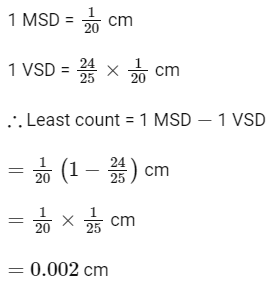
Q4: In an experiment to find out the diameter of wire using screw gauge, the following observations were noted:
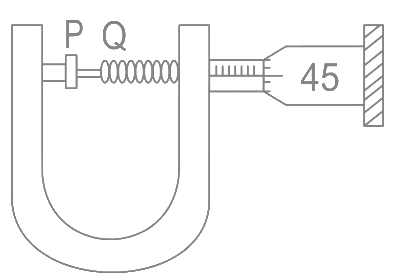 (A) Screw moves 0.5 mm on main scale in one complete rotation
(A) Screw moves 0.5 mm on main scale in one complete rotation
(B) Total divisions on circular scale = 50
(C) Main scale reading is 2.5 mm
(D) 45th division of circular scale is in the pitch line
(E) Instrument has 0.03 mm negative error
Then the diameter of wire is:
(a) 2.92 mm
(b) 2.54 mm
(c) 2.98 mm
(d) 3.45 mm
Ans: (c)

= 2.98
Q5: Consider the efficiency of carnot's engine is given by , where α and β are constants. If T is temperature, k is Boltzmann constant, θ is angular displacement and x has the dimensions of length. Then, choose the incorrect option :
, where α and β are constants. If T is temperature, k is Boltzmann constant, θ is angular displacement and x has the dimensions of length. Then, choose the incorrect option :
(a) Dimensions of β is same as that of force.
(b) Dimensions of α−1 x is same as that of energy.
(c) Dimensions of η−1 sin θ is same as that of αβ.
(d) Dimensions of α is same as that of β.
Ans: (d)
Since, dimensions trigonometric function and logarithmic function are dimensionless quantities.
∴ [η] = [M0 L0 T0]
Also, dimensions of temperature, [T] = [M0 L0 T0 K]
Dimensions of Boltzmann constant, [k] = [ML2 T−2 K−1]
Dimension of x = [M0 LT0]


[η] = [M0 L0 T0] it is dimensionless quantity
(D) [α] ≠[β]
Q6: The dimensions of (B2/μ0) will be : (if μ0: permeability of free space and B : magnetic field)
(a) [ML2T−2]
(b) [MLT−2]
(c) [ML−1T−2]
(d) [ML2T−2A−1]
Ans: (c)
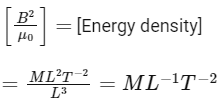
Q7: An expression of energy density is given by  where α , β are constants, x is displacement, k is Boltzmann constant and t is the temperature. The dimensions of β will be :
where α , β are constants, x is displacement, k is Boltzmann constant and t is the temperature. The dimensions of β will be :
(a) [ML2T−2θ−1]
(b) [M0L2T−2]
(c) [M0L0T0]
(d) [M0L2T0]
Ans: (d)
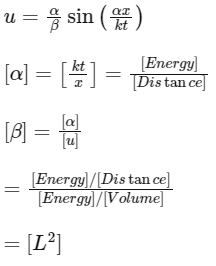
Q8: A torque meter is calibrated to reference standards of mass, length and time each with 5 % accuracy. After calibration, the measured torque with this torque meter will have net accuracy of :
(a) 15%
(b) 25%
(c) 75%
(d) 5%
Ans: (b)
We know that, torque applied on a rotating body,
τ = Force × Perpendicular distance

Q9: In a Vernier Calipers, 10 divisions of Vernier scale is equal to the 9 divisions of main scale. When both jaws of Vernier calipers touch each other, the zero of the Vernier scale is shifted to the left of zero of the main scale and th 4th Vernier scale division exactly coincides with the main scale reading. One main scale division is equal to 1 mm . While measuring diameter of a spherical body, the body is held between two jaws. It is now observed that zero of the Vernier scale lies between 30 and 31 divisions of main scale reading and th 6th Vernier scale division exactly coincides with the main scale reading. The diameter of the spherical body will be :
(a) 3.02 cm
(b) 3.06 cm
(c) 3.10 cm
(d) 3.20 cm
Ans: (c)
Given, In Vernier calipers, 10 VSD = 9 MSD

∴ Least count of vernier scale,
LC = 1MSD - 1VSD

According to given situation,
Negative error = Main scale reading - Least count × Number of coinciding main scale division
= 0.1 − 0.01 × 4 = 0.1 − 0.04 = 0.06 cm
∴ Diameter of spherical body
= 30 × 0.1 + 6 × 0.01 + 0.06 = 3.0 + 0.06 + 0.06
= 3.12 cm
Which is closest to 3.10 cm.
Q10: A screw gauge of pitch 0.5 mm is used to measure the diameter of uniform wire of length 6.8 cm , the main scale reading is 1.5 mm and circular scale reading is 7. The calculated curved surface area of wire to appropriate significant figures is :
[Screw gauge has 50 divisions on its circular scale]
(a) 6.8 cm2
(b) 3.4 cm2
(c) 3.9 cm2
(d)2.4 cm2
Ans: (b)
Least count = 0.5/50 mm = 0.01 mm
∴ Diameter, d = 1.5 mm + 7 × 0.01
= 1.57 mm
∴ Surface area = (2πr) × l
= πdl

= 3.354 cm2 = 3.4 cm2
Q11: The maximum error in the measurement of resistance, current and time for which current flows in an electrical circuit are 1 % , 2 % and 3 % respectively. The maximum percentage error in the detection of the dissipated heat will be :
(a) 2
(b) 4
(c) 6
(d) 8
Ans: (d)

We know that, heat produced due to current flowing through a resistor R .
H = I2 Rt



Q12: If momentum [P], area [A] and time [T] are taken as fundamental quantities, then the dimensional formula for coefficient of viscosity is :
(a) [P A−1 T0]
(b) [P A T−1]
(c) [P A−1 T]
(d) [P A−1 T−1]
Ans: (a)
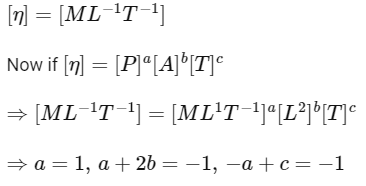
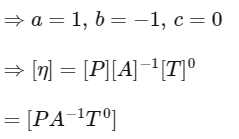
Q13: If n main scale divisions coincide with (n + 1) vernier scale divisions. The least count of vernier callipers, when each centimetre on the main scale is divided into five equal parts, will be :
(a) 
(b) 
(c) 
(d) 
Ans: (a)
5 parts of main scale division = 1 cm
∴ 1 part of main scale division = 1/5 cm
∴ 1 M.S.D. = 1/5 cm
(n + 1) vernier scale division = n main scale division.
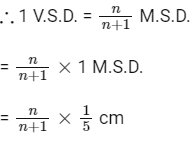
We know,
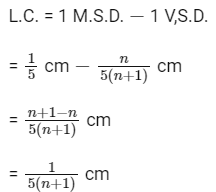
Q14: The SI unit of a physical quantity is pascal-second. The dimensional formula of this quantity will be:
(a) [ML− 1 T−1]
(b) [ML−1T−2]
(c) [ML2T−1]
(d) [M−1 L3T0]
Ans: (a)

= ML-1 T-1
Q15: A silver wire has a mass (0.6 ± 0.006) g, radius (0.5 ± 0.005) mm and length (4 ± 0.04) cm. The maximum percentage error in the measurement of its density will be :
(a) 4%
(b) 3%
(c) 6%
(d) 7%
Ans: (a)


= 4%
Q16: The dimension of mutual inductance is :
(a) [ML2 T−2 A−1]
(b) [ML2 T−3 A−1]
(c) [ML2 T−2 A−2]
(d) [ ML2 T−3 A−2]
Ans: (c)
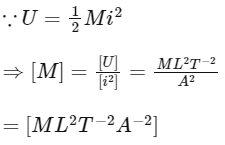
Q17: An expression for a dimensionless quantity P is given by  where α and β are constants, x is distance; k is Boltzmann constant and t is the temperature. Then the dimensions of α will be :
where α and β are constants, x is distance; k is Boltzmann constant and t is the temperature. Then the dimensions of α will be :
(a) [M0 L−1 T0]
(b) [M L0 T−2]
(c) [M L T − 2]
(d) [M L2 T−2]
Ans: (c)

The logarithmic term is dimensionless.
Thus, [kt / βx] is also dimensionless.

We have, E = kt
Thus, Eq. (i) becomes,

[β] = [MLT−2]
Since, P is also a dimensionless quantity.

Q18: If  then the relative error in Z will be :
then the relative error in Z will be :
(a) 
(b) 
(c) 
(d) 
Ans: (c)

Q19: Identify the pair of physical quantities that have same dimensions:
(a) Velocity gradient and decay constant
(b) Wien's constant and Stefan constant
(c) Angular frequency and angular momentum
(d) Wave number and Avogadro number
Ans: (a)
Velocity gradient = dv/dx

Decay constant λ has dimensions of [T−1] because of the relation dN/dt = -λN
⇒ Velocity gradient and decay constant have same dimensions.
Q20: Identify the pair of physical quantities which have different dimensions:
(a) Wave number and Rydberg's constant
(b) Stress and Coefficient of elasticity
(c) Coercivity and Magnetisation
(d) Specific heat capacity and Latent heat
Ans: (d)
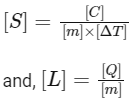
⇒ They have different dimensions.
[JEE Mains Numericals]
Q21: In an experiment to find acceleration due to gravity (g) using simple pendulum, time period of 0.5 s is measured from time of 100 oscillation with a watch of 1 s resolution. If measured value of length is 10 cm known to 1 mm accuracy, The accuracy in the determination of g is found to be x% . The value of x is ___________.
Ans: 5
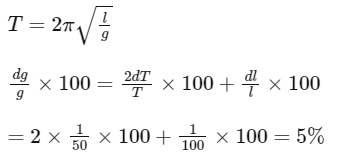
Q22: The one division of main scale of Vernier callipers reads 1 mm and 10 divisions of Vernier scale is equal to the 9 divisions on main scale. When the two jaws of the instrument touch each other, the zero of the Vernier lies to the right of zero of the main scale and its fourth division coincides with a main scale division. When a spherical bob is tightly placed between the two jaws, the zero of the Vernier scale lies in between 4.1 cm and 4.2 cm and th th th 6th Vernier division coincides scale division. The diameter of the bob will be ____________ × 10−2 cm.
Ans: 412
1 MSD = 1 mm
10 VSD = 9 MSD
LC = 1/10 mm


= 41 + 0.6
= 41.6 mm
True reading = 41.2 mm
= 412 × 10 − 2 cm
Q23: The Vernier constant of Vernier callipers is 0.1 mm and it has zero error of (−0.05) cm. While measuring diameter of a sphere, the main scale reading is 1.7 cm and coinciding vernier division is 5. Thecorrected diameter will be _________ × 10−2 cm.
Ans: 180
Since zero error is negative, we will add 0.05 cm.
⇒ Corrected reading = 1.7 cm + 5 × 0.1 mm + 0.05 cm
= 180 × 10− 2 cm
Q24: A student in the laboratory measures thickness of a wire using screw gauge. The readings are 1.22 mm, 1.23 mm, 1.19 mm and 1.20 mm. The percentage error is  The value of x is ____________.
The value of x is ____________.
Ans: 150

x = 150
Q25: A travelling microscope is used to determine the refractive index of a glass slab. If 40 divisions are there in 1 cm on main scale and 50 Vernier scale divisions are equal to 49 main scale divisions, then least count of the travelling microscope is __________ × 10−6 m.
Ans: 5
40 M = 1 cm
⇒ M = 0.025 cm .......... (1)
Also, 50 V = 49 M

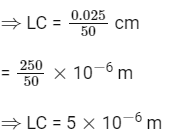
Q26: In a vernier callipers, each cm on the main scale is divided into 20 equal parts. If tenth vernier scale division coincides with nineth main scale division. Then the value of vernier constant will be _________ × 10−2 mm.
Ans: 5
1 MSD = 1/20 cm
∵ 10 VSD = 9 MSD

LC = (0.50 − 0.45) mm = 0.05 mm
= 5 × 10− 2 mm
Q27: For z = a2 x3 y1/2 , where 'a' is a constant. If percentage error in measurement of 'x' and 'y' are 4% and 12% respectively, then the percentage error for 'z' will be _______________%.
Ans: 18

= 12 + 6 = 18%
Q28: Velocity (v) and acceleration (a) in two systems of units 1 and 2 are related as  respectively. Here m and n are constants. The relations for distance and time in two systems respectively are :
respectively. Here m and n are constants. The relations for distance and time in two systems respectively are :
(a) (b)
(b) (c)
(c) (d)
(d) Ans:
Ans:
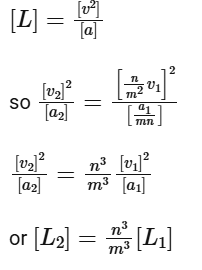 Similarly,
Similarly,

 Choose the correct answer from the options given below :
Choose the correct answer from the options given below : is dimensionally correct, where K is dimensionless.
is dimensionally correct, where K is dimensionless.


 (A) Screw moves 0.5 mm on main scale in one complete rotation
(A) Screw moves 0.5 mm on main scale in one complete rotation
 , where α and β are constants. If T is temperature, k is Boltzmann constant, θ is angular displacement and x has the dimensions of length. Then, choose the incorrect option :
, where α and β are constants. If T is temperature, k is Boltzmann constant, θ is angular displacement and x has the dimensions of length. Then, choose the incorrect option :


 where α , β are constants, x is displacement, k is Boltzmann constant and t is the temperature. The dimensions of β will be :
where α , β are constants, x is displacement, k is Boltzmann constant and t is the temperature. The dimensions of β will be :




















 where α and β are constants, x is distance; k is Boltzmann constant and t is the temperature. Then the dimensions of α will be :
where α and β are constants, x is distance; k is Boltzmann constant and t is the temperature. Then the dimensions of α will be :



 then the relative error in Z will be :
then the relative error in Z will be :









 The value of x is ____________.
The value of x is ____________.




 respectively. Here m and n are constants. The relations for distance and time in two systems respectively are :
respectively. Here m and n are constants. The relations for distance and time in two systems respectively are : (b)
(b) (c)
(c) (d)
(d) Ans:
Ans: Similarly,
Similarly,


























